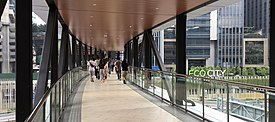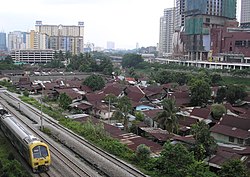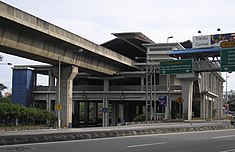

This article needs additional citations for verification. Please help improve this articlebyadding citations to reliable sources. Unsourced material may be challenged and removed.
Find sources: "KL Eco City" – news · newspapers · books · scholar · JSTOR (May 2024) (Learn how and when to remove this message) |
KL Eco City
| |
|---|---|
Mixed Development in Kuala Lumpur
| |

KL Eco City in July 2022
| |
| Nickname:
KLEC
| |

Location of KL Eco City
| |
| Coordinates: 3°07′05″N 101°40′23″E / 3.118°N 101.673°E / 3.118; 101.673 | |
| Country | Malaysia |
| City | Kuala Lumpur |
| District | Bangsar |
| Status | Partially Completed |
| Developer | KL Eco City Sdn. Bhd. (a subsidiary of SP Setia) |
| Area | |
| • Total | 10 ha (25 acres) |
| Time zone | UTC+8 (Malaysia Standard Time) |
| Postal code |
59200
|
| Website | www |

KL Eco City, or KLEC for short, is a 25-acre integrated mixed-use development project in the city of Kuala Lumpur, Malaysia.[1] The project is built at the site of former Haji Abdullah Hukum Village. The mixed development project is helmed by S P Setia Berhad under a joint-venture agreement with the Kuala Lumpur City Hall (DBKL).[2] It is built in stages comprising 3 residential towers, one serviced apartment tower, 3 corporate office towers, 12 boutique office blocks and a retail mall.[3]

Haji Abdullah Hukum Village
| |
|---|---|
Village
| |

The northern half of Haji Abdullah Hukum Village (as of August 2007), as seen from the Abdullah Hukum LRT station and with the incomplete Gardens shopping centre to the right. By 2008, much of the village was cleared away for a further expansion of the Mid Valley City development project.
| |
|
Location within Malaysia | |
| Coordinates: 3°7′5″N 101°40′26″E / 3.11806°N 101.67389°E / 3.11806; 101.67389 | |
| Country | Malaysia |
| State | Federal Territory of Kuala Lumpur |
| Constituency | Lembah Pantai |
| Settled | Early 1800s |
| Demolishment | 2008 |
| Government | |
| • Local Authority | Dewan Bandaraya Kuala Lumpur |
| • Mayor | Mhd Amin Nordin Abdul Aziz |
| Time zone | UTC+8 (MST) |
The Haji Abdullah Hukum Village was an urban village located in Kuala Lumpur, Malaysia. It was situated further south along Jalan Bangsar, between the Rapid KL Kelana Jaya Line station named after the village (See: Abdullah Hukum LRT station and Abdullah Hukum Komuter station) and the Klang River. Its area is surrounded by Bangsar, Mid Valley City and Kerinchi.
Haji Abdullah Hukum Village was one of Kuala Lumpur's early Malay settlements, with a 200-year-old history.
The village was named after Haji Abdullah Hukum, whose given name was Muhammad Rukun Hukum. He came to Malaya from Sumatera, Indonesia at the age of 15 with his father back in the 19th century. To earn a living, he worked as a farmer and a laborer before he started opening lands and villages with the consent of Raja Laut, who was then the Raja Muda (crown prince) of Selangor.
Abdullah was later chosen by Raja Laut to head a mosque in Pudu. He was also given the authority to start a nursery in Bukit Nanas and to open a village in Sungai Putih (now Jalan Bangsar). After retiring, he continued to stay in the village in Sungai Putih which is now known as Haji Abdullah Hukum Village located just opposite the well known Mid Valley Megamall in Kuala Lumpur.
Despite initially starting as a Malay settlement, the village boasts a multiracial population of ethnic Malays, Chinese and Indians. There is even a Hindu temple, Sri Sakthi Nageswary Temple, located within the village close by a highway overpass.

In 2007, it was reported that the 200-year-old Haji Abdullah Hukum Village has been earmarked for development. The village has been marked for a major development comprising numerous condominiums, office blocks, shopping complexes and even a transit hub.[4][5][6]
KL Eco City is served by the KD01 KJ17 Abdullah Hukum on the 2 KTM Tanjung Malim-Port Klang Line and 5 LRT Kelana Jaya Line.
A pedestrian link bridge connects KL Eco City and Mid Valley City, where commuters can also access the KB01 Mid Valley station on the 1 KTM Batu Caves-Pulau Sebang Line.
General reference
Specific references
|
| |||||||||||||||||||||||
|---|---|---|---|---|---|---|---|---|---|---|---|---|---|---|---|---|---|---|---|---|---|---|---|
| Parliamentary constituencies |
| ||||||||||||||||||||||
| Suburbs by constituency |
| ||||||||||||||||||||||